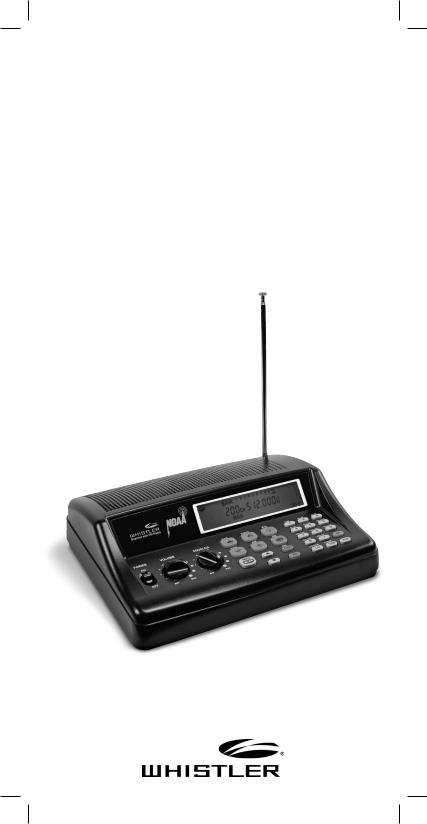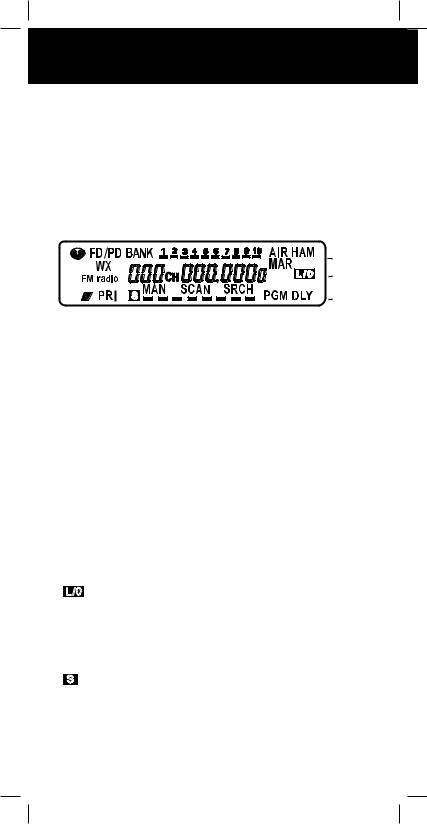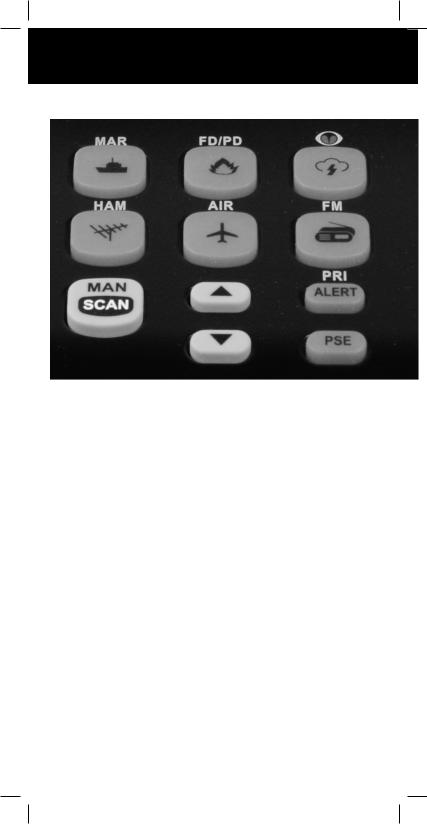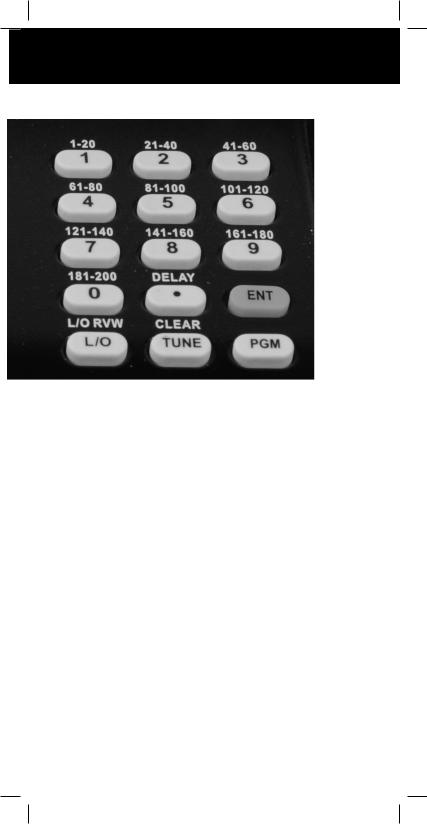Whistler WS1025 User Manual [nl]

WS1025
200 Channel VHF/Air/UHF
Desktop Scanner
OWNER’S MANUAL

TABLE OF CONTENTS |
|
Package Contents...................................................... |
3 |
Scanning Legally........................................................ |
3 |
Features..................................................................... |
4 |
Scanner Basics............................................................ |
5 |
Setup.......................................................................... |
6 |
Connecting the Antenna................................................... |
6 |
Connecting a Speaker or Headphones............................. |
7 |
Powering Your Scanner..................................................... |
7 |
Turning on the Scanner..................................................... |
7 |
Turning Off the Key Tone.................................................. |
8 |
Understanding the Display................................................ |
8 |
Understanding the Keypad............................................. |
10 |
Configuring Your Scanner........................................ |
12 |
Preprogrammed Frequencies.......................................... |
12 |
Programming Channels................................................... |
12 |
Programming with a Computer....................................... |
13 |
Cloning Programmed Data............................................. |
13 |
Searching for Frequencies........................................ |
14 |
Service Bank Search........................................................ |
14 |
Storing Found Frequencies............................................. |
14 |
Birdie Frequencies.......................................................... |
15 |
Scanning Stored Channels.............................................. |
15 |
Monitoring a Channel..................................................... |
17 |
Locking Out Channels..................................................... |
18 |
Clearing a Stored Channel.............................................. |
18 |
Weather Features..................................................... |
19 |
Receiving All Weather Alerts.......................................... |
19 |
Receiving Alerts for Specific Areas................................. |
19 |
SAME Standby Mode..................................................... |
20 |
Skywarn™...................................................................... |
21 |
Additional Information............................................. |
22 |
Care................................................................................ |
22 |
Initializing the Scanner................................................... |
22 |
Preprogrammed Frequency List..................................... |
23 |
Service Banks ................................................................ |
26 |
Specifications................................................................. |
29 |
FCC Notice.................................................................... |
30 |
Limited Warranty............................................................ |
31 |
2

INTRODUCTION
WELCOME
Thank you for choosing a Whistler product. We are dedicated to providing products that represent both quality and value. Please read the user manual carefully before using this product. If you have additional questions, please visit the FAQ page
on our website at www.whistlergroup.com or call toll free 800-531-0004, 8am to 5pm CT, Monday through Friday to speak to a Customer Service Representative.
Package Contents
•Scanner
•Antenna
•AC Adapter
•User’s Guide
•Quick Start Guide
Scanning Legally
Your scanner covers frequencies used by many different groups including police and fire departments, ambulance services, government agencies, private companies, amateur radio services, military operations, pager services, and wireline (telephone and telegraph) service providers. It is legal to listen to almost every transmission your scanner can receive. However, there are some transmissions you should never intentionally listen to.
These include:
•Telephone conversations (cellular, cordless, or other private means of telephone signal transmission)
•Pager transmissions
•Any scrambled or encrypted transmissions
According to the Electronic Communications Privacy Act (ECPA), as amended, you are subject to fines and possible imprisonment for intentionally listening to, using, or divulging the contents of such a transmission unless you have the consent of a party to the communication (unless such activity is otherwise illegal).
3

FEATURES
This scanner is designed to prevent reception of illegal transmissions, in compliance with the law which requires that scanners be manufactured in such a way as to not be easily modifiable to pick up those transmissions. Do not open your scanner’s case to make any modifications that could allow it to pick up transmissions that are not legal to listen to. Doing so could subject you to legal penalties.
In some areas, mobile use of this scanner is unlawful or requires a permit. Check the laws in your area. We encourage responsible, legal scanner use.
Features
Your new WS1025 Desktop Scanner lets you scan conventional transmissions, and is preprogrammed with search banks for convenience. By pressing a one touch search key, you can quickly search those frequencies most commonly used by public service and other agencies without tedious and complicated programming.
This scanner gives you direct access to over 26,000 exciting frequencies, including those used by ambulance services, aircraft, and amateur radio services, marine, civil air patrol, VHF and UHF business bands, government frequencies and some police and fire departments.
Your scanner also has these special features: One-Touch Service Search Banks – Lets you search preset frequencies in separate marine, fire/police, aircraft, ham, FM Radio and weather bands. Display Backlight – Easy to read in low-light situations.
Lockout Function – Lets you skip specified channels or frequencies when scanning or searching.
Ten Channel-Storage Banks – You can store 20 channels in each bank (200 total channels), letting you group channels so you can more easily identify calls.
SAME/FIPS Weather Alert – Displays weather events for the county or counties that you choose. Memory Backup – Keeps the frequencies stored in memory for an extended time.
4

SCANNER BASICS
Scan Delay – Delays scanning for about 2 seconds, so that you can hear replies on the same channel. Priority Channel – Lets you set the scanner to check one channel every 2 seconds so that you do not miss transmissions on that channel.
Data Cloning – Lets you transfer the programmed data to another WS1025 scanner.
External Antenna Connector – Lets you connect an external antenna (not supplied) with a BNC connector for improved reception of distant/weaker signals.
Scanner Basics
After you familiarize yourself with your scanner’s features you can then set up your scanner.
Frequencies
A frequency is the waveband of the transmitting signal (expressed in kHz or MHz). Your WS1025 receives a range of analog frequencies; the best resource for your local frequencies is www.radioreference.com.
Also, you can use your scanner’s search functions to find active frequencies in your area.
Your WS1025 scanner can receive these bands:
Frequency Range |
Types of Transmissions |
|
|
29–54 MHz |
10-Meter Ham, VHF Lo, 6-Meter |
|
Ham |
87.3–107.9 MHz |
FM Broadcast |
108–136.99166 |
Aircraft |
MHz |
|
137–174 MHz |
Military Land Mobile, 2-Meter Ham, |
|
VHF Hi |
380–512 MHz |
UHF Aircraft, Federal Government, |
|
70-cm Ham, UHF Standard, UHF |
|
“T” |
nNote: See “Specifications” on page 29 for more information about frequency steps.
5

CONNECTING ANTENNA
Channels
Channels are storage areas for frequencies saved in your scanner’s memory. Each saved frequency is assigned a channel.
Banks
A bank is a storage area for a group of channels. Your scanner provides 10 banks (1 to 10) that can each store up to 20 channels, for a total of 200 channels. You can use the banks to group and organize frequencies.
For example, you could program the frequencies used by your local police department starting with Channel 1 (the first channel in bank 1) and program the fire department frequencies starting with Channel 21 (the first channel in bank 2).
Setup
Connecting the Antenna
To attach the supplied telescopic antenna, insert the antenna in the hole on the top of the scanner and turn the antenna clockwise to tighten.
Connecting an Outdoor Antenna
To connect an external antenna, follow the installation instructions supplied with the antenna. Use 50 Ohm coaxial cable, such as RG-58 or RG-8. For lengths over 50 feet, use RG-8 low-loss dielectric coaxial cable. If the antenna cable’s connector does not have a BNC connector, you will also need a BNC adapter.
wWarning: Use extreme caution when installing or removing an outdoor antenna. If the antenna starts to fall, let it go! It could contact overhead power lines. If the antenna touches a power line, touching the antenna, mast, cable, or guy wires can cause electrocution and death. Call the power company to remove the antenna. DO NOT attempt to do so yourself.
6

CONNECTING ACCESSORIES
Connecting a Speaker or Headphones
You can plug an amplified speaker or headphones (not supplied) with Çinch (3.5 mm) mini-plug into the HEADPHONE jack on the back of the scanner. This automatically disconnects the internal speaker. Note: Use an amplified speaker with this scanner. Non-amplified speakers do not provide sufficient volume for comfortable listening.
Listening Safely
To protect your hearing, follow these guidelines:
•Do not listen at high volume levels. Extended high-volume listening can lead to permanent hearing loss.
•Set the volume to the lowest setting. Then turn on your audio device and adjust the volume to a comfortable level.
•Avoid increasing the volume. Your ears will adapt to the volume level, so a level that does not cause discomfort could still damage your hearing.
Powering Your Scanner
1.Connect the supplied adapter to the scanner’s
DC 9V jack and a standard power outlet.
2.To disconnect, unplug the adapter from the power source first.
Caution: You must use a Class 2 power source that supplies 9V DC and delivers at least 400mA. Its center tip must be set to positive and its plug must fit the scanner’s DC 9V jack. Using an adapter that does not meet these specifications could damage the
scanner or the adapter.
Turning on the Scanner
1.Turn the SQUELCH all the way down before you turn on the scanner.
2.Slide POWER to ON. A welcome message appears. After about 3 seconds, adjust VOLUME to a comfortable level.
3.Turn SQUELCH clockwise, just until the hissing sound stops. If you always hear a hissing sound, the scanner will not scan or search properly.
•To listen to a weak or distant station, turn
SQUELCH counterclockwise.
•If reception is poor, turn SQUELCH clockwise to cut out weak transmissions.
7

DISPLAY
Turning Off the Key Tone
The scanner is preset to sound a tone each time you press one of its keys.
To turn the key tone on and off:
1.Turn on the scanner. WELCOME SCAnnInG rECEIVEr appears.
2.While the welcome message is on the screen, press 1 to turn on the key tone or press 2 to turn it off.

 Row 1
Row 1
 Row 2
Row 2

 Row 3
Row 3
Understanding the Display
Row 1
 – Skywarn channel active.
– Skywarn channel active.
FD/PD – Searching the fire/police bank.
BANK – Indicates the scan bank(s). A bar appears under the numbers for banks that are turned on. AIR – Searching the aircraft bank.
HAM – Searching the amateur radio bank.
Row 2
WX – Searching weather channels.
FM radio – Searching for FM radio stations. 000 – Channel number the scanner is tuned to. CH – Appears with channel number (1–200) or P (priority channel).
000.0000 – Frequency the scanner is tuned to. MAR – Searching the marine bank.
L/0 – A locked out channel/frequency is manually
selected or reviewed.
Row 3
ed (Up/Down) – Search or scan direction. PRI – Priority feature is active.
S – Signal meter; bars indicate strength of signal. MAN – Manual mode.
SCAN – Scan mode.
SRCH – Searching a service bank. PGM – Program mode.
DLY – Two-second delay is active.
8

DISPLAY
Display Messages
ALL CH L-out – All channels locked out during scan or marine band search.
b X Ch-FULL – All displayed bank channels are full. b X StorE – Frequency programmed into displayed bank’s channel.
CLOnE – Clone mode.
-dUPL- – Frequency is already stored in another channel.
Error – Entry error.
FLo ALL- CL – All the locked-out frequencies removed during a FD/PD, AIRCRAFT, or HAM bank search.
L-r – Review the locked-out frequencies.
L-O Fr-FULL – Maximum of 50 frequencies already locked out.
oFF tonE – Key tone deactivated. On tonE – Key tone activated.
P – Scanner is tuned to the priority channel. -t- – Tune mode.
Sub Bank Messages
Lo VHF – Sub-bank 1 of the fire/police bank. Hi VHF – Sub-bank 2 of the fire/police bank. UHF – Sub-bank 3 of the fire/police bank.
10 M – Sub-bank 1 of the HAM bank. 6 M – Sub-bank 2 of the HAM bank. 2 M – Sub-bank 3 of the HAM bank.
70CM – Sub-bank 4 of the HAM bank.
9

KEYPAD
Understanding the Keypad
MAR – Search the preprogrammed marine bank. FD/PD – Search the preprogrammed fire/police bank.
 – Search the preprogrammed weather bank, or press and hold to jump to the Skywarn channel. You must first program your local Skywarn frequency into channel 200 (see page 22).
– Search the preprogrammed weather bank, or press and hold to jump to the Skywarn channel. You must first program your local Skywarn frequency into channel 200 (see page 22).
HAM – Search the preprogrammed amateur radio bank. AIR – Search the preprogrammed aircraft bank.
FM – Search FM radio stations.
SCAN / MAN (Manual) – Enter Scan mode to scan programmed channels. Enter Manual mode to stop scanning, directly enter a channel number, or monitor a single channel.
– Select the direction for searching and scanning.
PRI / ALERT – Enable and disable the priority feature. Enable and disable SAME standby mode when monitoring a weather channel.
PSE (Pause) – Stop and restart a search or tune.
10

KEYPAD
0–9 – Input numbers when entering frequencies and selecting banks (0 selects bank 10). The number range above the keys (1–20, 21–40, 41-60, etc.) indicates the channels stored in that bank.
• / DELAY – Input a decimal point when entering frequencies. Set a two-second delay for a selected channel.
ENT (Enter) – Complete the entry of a frequency.
L/O / L/O RVW – Lock-out selected channels or frequencies. Review locked-out frequencies.
TUNE / CLEAR – Enter Tune search. Clear an incorrect entry.
PGM – Program frequencies into channels.
11
